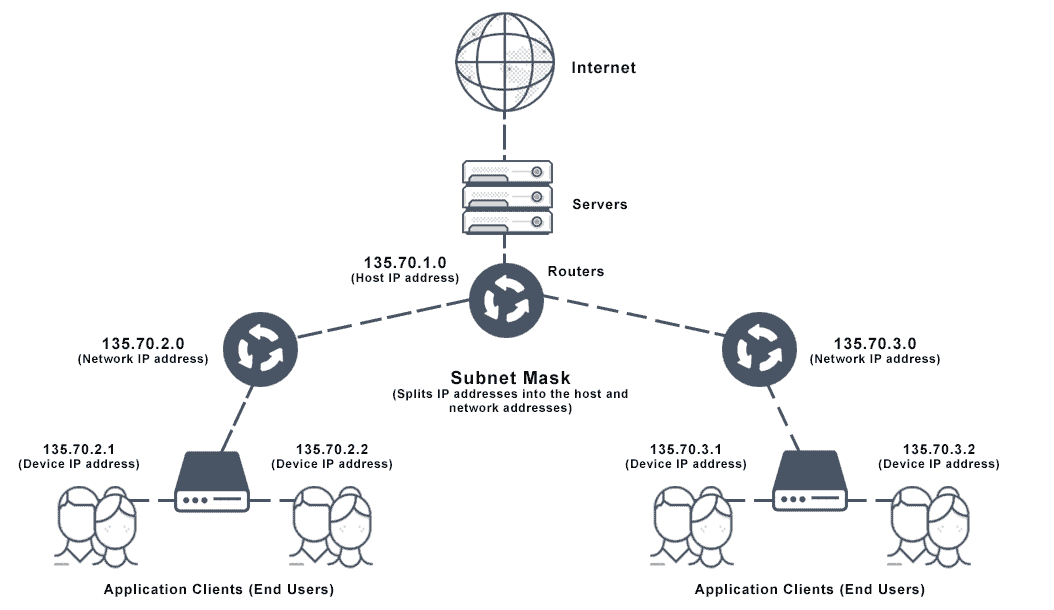Welcome to our deep dive into subnet masks! This guide is here to unravel the complexities of subnet masks in a simple yet professional manner. Whether you're new to networking or looking to refresh your knowledge, this guide will walk you through the essentials of subnet masks in an easy-to-understand format.
Understanding Subnet Masks
A subnet mask is a key player in network organization. It's like a blueprint that helps in dividing a larger network into smaller sections, called subnets. Think of a subnet mask as a tool that helps in sorting and managing IP addresses more effectively.

Every gadget connected to a network has an IP address, which is split into two key sections: the host (think of it as the "client") side and the network (or "server") side. How these IP addresses get set up can vary - sometimes they're automatically assigned by something called a DHCP server, or they can be manually set up as static IP addresses. The subnet mask comes into play here, acting like a divider. It neatly separates the IP address into the host and network parts, making it clear which bit of the IP address is for the individual device and which bit is for the network it's part of.
Now, there's this important device in the network world called a gateway, or what's often called the default gateway. Its job is to connect all the local devices – like your computer or phone – to other, far-off networks. So, if your device needs to send information to another device that's not on your local network, it first passes this information to the gateway. The gateway then has the job of sending these data packets off to wherever they need to go, outside of your local network.
The Role of IP Addresses and Subnet Masks
Every device on a network has an IP address, a unique identifier. A subnet mask works with this IP address to categorize parts of the network. It's a bit like separating a large group of people into smaller teams, making it easier to manage and communicate within those teams.
Classes of IP Addresses and Their Subnet Masks
There are different classes of IP addresses, each with its default subnet mask:
- Class A: Big networks, default subnet mask is 255.0.0.0.
- Class B: Medium networks, default subnet mask is 255.255.0.0.
- Class C: Small networks, default subnet mask is 255.255.255.0.
These defaults are just starting points; they can be adjusted for better network management.
The Process of Subnetting
Subnetting splits one network into several smaller ones. It involves tweaking the host part of the IP address to create new network addresses. This makes managing networks more efficient, improves performance, and enhances security.
Network Addressing Simplified
A subnet mask is crucial in figuring out the network's address. You find the network address by combining the IP address with the subnet mask. This address represents the whole network.
Subnet Mask Calculators: A Handy Tool
A subnet mask calculator is a handy tool in networking. It calculates subnet masks and other important network information, making life easier, especially in big networks where manual calculations can be tricky.
Some individuals are skilled in manually computing subnet masks, yet the majority prefer using subnet mask calculators for ease and accuracy. There's a variety of these calculators, each tailored to different network needs. Some are comprehensive, offering a broad range of functions, while others focus on specific tasks. Commonly, these tools assist in determining details like IP range, specific IP addresses, subnet masks, and network addresses.
Let's explore the diverse types of IP subnet mask calculators available:
- IPv6 IP Subnet Calculator: This tool specializes in organizing hierarchical subnets for IPv6 addresses.
- IPv4/IPv6 Calculator/Converter: It's a versatile calculator that handles both IPv4 and IPv6 formats, including IPv6's alternative and condensed versions. This calculator also enables conversion between IPv4 and IPv6 address formats.
- IPv4 CIDR Calculator: This calculator is designed for adjusting subnet masks and converting them into Hex format for IPv4 addresses.
- IPv4 Wildcard Calculator: It calculates the wildcard mask for an IP address, helping to identify the variable parts of the IP address for further analysis.
- HEX Subnet Calculator: Use this tool to find the first and last addresses in a subnet, including hexadecimal representations for multicast addresses.
- Simple IP Subnet Mask Calculator: Ideal for quickly determining the smallest possible subnet and its corresponding subnet mask.
- Subnet Range/Address Range Calculator: This calculator provides the starting and ending addresses within a subnet.
Each of these calculators serves a unique purpose, making subnet management more efficient and tailored to specific networking requirements.
IP Mask: Another Name for Subnet Mask
IP Mask is just another way to say subnet mask. It's all about identifying which part of an IP address belongs to the network. This is super important for routing data to the right place in a network.
In summary, subnet masks are vital in organizing and managing networks. They make sure data goes where it's supposed to. This guide aimed to break down the concept of subnet masks into something more digestible. Understanding subnet masks is crucial for anyone in cybersecurity, network management or design.


